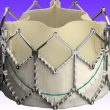At present TAVR is a valid alternative to treat different risk groups of patients with severe aortic stenosis. Among the different valves, there are two types, the self-expanding (SEV) and the balloon expandable (BEV) valves, that are the most implanted and the most researched by randomized studies across different risk groups. There are different generations...
Pulmonary Artery Denervation: Valid Alternative for Pulmonary Arterial Hypertension Grade 1?
Pulmonary vessels are densely innervated by sympathetic, parasympathetic, and sensitive fibers. According to the World Health Organization (WHO) pulmonary arterial hypertension (PAH) grade 1 consists of obliterating pulmonary vascular remodeling accompanied by a diminished generation of vessel dilators. Its pharmacological treatment has certain limitations and sympathetic pulmonary vascular denervation might be a valid treatment alternative,...
Mitral Trial: 2-Year Followup
At present, an important group of patients with mitral valve disease are at high surgical risk, especially those with deteriorated bio-prosthesis, severe mitral annulus calcification or those who had received mitral annuloplasty. Percutaneous treatment with balloon expandable valves is a valid option to treat these patients, seeing as their 30 day and one-year outcomes look...
Valve-in-Valve Shows Good Evolution after 2 Years
The degeneration of bioprostheses in aortic position occurs at approximately after 10 to 15 years. In this scenario, the treatment of choice used to be redo surgery, but with the evolution of transcatheter aortic valve replacement (TAVR), it became a valid alternative with a level IIa B evidence. While there are currently multiple analyses of...
Post PCI FFR
Much research has been done on the usefulness of functional testing such as fractional Flow reserve (FFR) after percutaneous coronary intervention (PCI), resulting in the correlation of pathological FFR values with major adverse events at 6 months, as shown by Pijls, et al. The impact of post PCI FFR on prognosis has not been studied...
Long-Term Mortality in Non-Obstructive Lesions in the Left Main Coronary Artery
Left main coronary artery (LMCA) intervention with significant lesions on both coronary angiography and intravascular ultrasound (IVUS), either through angioplasty (PCI) or myocardial revascularization surgery (MRS), is directly related to a decrease in long-term adverse clinical events. However, the relationship between subclinical LMCA disease (preserved luminal diameters) and long-term mortality is still unknown. A retrospective...
We Should Start Considering Pulmonary Hypertension After TAVR
Pulmonary hypertension is associated with higher mortality after both aortic valve replacement and transcatheter aortic valve replacement (TAVR). This is a dynamic phenomenon, and what happens after TAVR —during the periprocedure— and its impact are yet to be evaluated. Researchers conducted a subanalysis of the Japanese OCEAN TAVI Registry, which included 1872 patients who were divided...
A Simple Score for Mortality and Cardiac Failure after Edge-to-Edge with MitraClip
Mitral regurgitation (MR) is the most frequent type of valve heart disease, and the COAPT has shown that edge-to-edge with guideline directed medical treatment (GDMT) at maximal tolerated dose (MTD) is superior to medical treatment alone. However, we did not have a score to predict patient evolution when treated with this strategy. Researchers analyzed the...
TCT 2022 | Edge-to-Edge Repair in Patients with Severe Mitral Insufficiency and Cardiogenic Shock: Analysis of the TVT Registry
Approximately 1 in 5 patients admitted for cardiogenic shock (CS) were observed to have moderate to severe mitral insufficiency (MI), which increases the risk of mortality by about 60%. To date, there is limited data on the role of transcatheter edge-to-edge repair therapy in this setting. The aim of this study was to describe the...
TCT 2022 | Pulmonary Artery Denervation in Primary Pulmonary Hypertension
Primary Pulmonary Hypertension is behind multiple hospitalizations and pulmonary transplants. Even though its treatment has been advanced, many patients will not respond well. The PADN-CFDA randomized 128 patients, 63 received pulmonary denervation (PADN) and 65 went to the control group. Primary end point was 6-minute walk distance test at 6 months. The populations were similar,...







